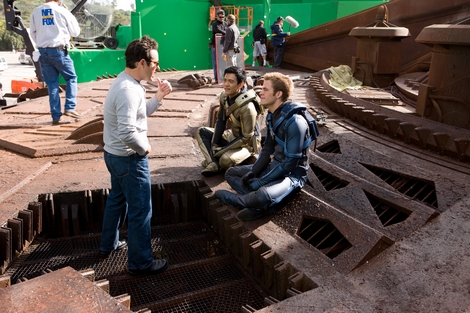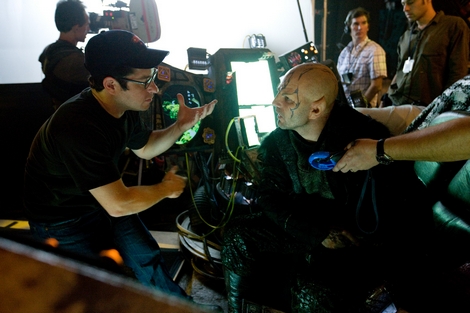* * * * * * * * * * *
Bard, now corrections chief of operations, denied ever talking to McAdory about the matter but defended the transfer, saying smoking crack cocaine in prison constitutes a major threat to safety and security.
Fox, a reputed white supremacist gang member, has spent most of his adult life in prison for burglary, theft, armed robbery and murder. His violence continued behind bars, with numerous assaults and death threats, according to the records.
Once in 2002, he repeatedly punched his cellmate, leading him to cower under the bunk. "On my son's name, if you come out from under that bed, I will kill you," records show the cellmate quoted Fox as telling him.
30 December 2009
Where the hell is John Wayne when you need him?
What a way to end a disasterous decade!
And now, our article, written in 2006 and once again relevant:
"Our Indian Wars Are Not Over Yet"
( General Analysis on Empire )
Ten Ways to Interpret the War on Terror as a Frontier Conflict
By John Brown*
TomDispatch
January 19, 2006
The Global War on Terror (GWOT) is, like all historical events, unique. But both its supporters and opponents compare it to past U.S. military conflicts. The Bush administration and the neocons have drawn parallels between GWOT and World War II as well as GWOT and the Cold War. Joshua E. London, writing in the National Review, sees the War on Terror as a modern form of the struggle against the Barbary pirates. Vietnam and the Spanish-American War have been preferred analogies for other commentators. A Pulitzer-prize winning journalist, Anne Applebaum, says that the war in Iraq might be like that in Korea, because of "the ambivalence of their conclusions." For others, the War on Terror, with its loose rhetoric, brings to mind the "war on poverty" or the "war on drugs."
I'd like to suggest another way of looking at the War on Terror: as a twenty-first century continuation of, or replication of, the American Indian wars, on a global scale. This is by no means something that has occurred to me alone, but it has received relatively little attention. Here are ten reasons why I'm making this suggestion:
1. Key supporters of the War on Terror themselves see GWOT as an Indian war. Take, for example, the right-wing intellectuals Robert Kaplan and Max Boot who, although not members of the administration, also advocate a tough military stance against terrorists. In a Wall Street Journal article, "Indian Country," Kaplan notes that "an overlooked truth about the war on terrorism" is that "the American military is back to the days of fighting the Indians." Iraq, he notes, "is but a microcosm of the earth in this regard." Kaplan has now put his thoughts into a book, Imperial Grunts: The American Military on the Ground, which President Bush read over the holidays. Kaplan points out that "'Welcome to Injun Country' was the refrain I heard from troops from Colombia to the Philippines, including Afghanistan and Iraq.... The War on Terrorism was really about taming the frontier."
As for Max Boot, he writes, "‘small wars' -- fought by a small number of professional U.S. soldiers -- are much more typical of American history than are the handful of ‘total' wars that receive most of the public attention. Between 1800 and 1934, U.S. Marines staged 180 landings abroad. And that's not even counting the Indian wars the army was fighting every year until 1890." A key GWOT battlefield, Boot suggests, is Afghanistan, noting that "[i]f the past is any indication of the future, we have a lot more savage wars ahead."
2. The essential paradigm of the War of Terror -- us (the attacked) against them (the attackers) -- was no less essential to the mindset of white settlers regarding the Indians, starting at least from the 1622 Indian massacre of 347 people at Jamestown, Virginia. With rare exceptions, newly arrived Europeans and their descendants, as well as their leaders, saw Indians as mortal enemies who started the initial fight against them, savages with whom they could not co-exist. The Declaration of Independence condemned "the inhabitants of our frontiers, the merciless Indian Savages whose known rule of warfare, is an undistinguished destruction of all ages, sexes and conditions." When governor of Virginia (1780), Thomas Jefferson stated:
"If we are to wage a campaign against these Indians the end proposed should be their extermination, or their removal beyond the lakes of the Illinois River. The same world would scarcely do for them and us."
President Andrew Jackson, whose "unapologetic flexing of military might" has been compared to George W. Bush's modus operandi, noted in his "Case for the Removal [of Indians] Act" (December 8, 1830):
"What good man would prefer a country covered with forests and ranged by a few thousand savages to our extensive Republic, studded with cities, towns, and prosperous farms, embellished with all the improvements which art can devise or industry execute, . . . and filled with all the blessings of liberty, civilization, and religion?"
Us vs. them is, of course, a feature of all wars, but the starkness of this dichotomy -- seen by GWOT supporters as a struggle between the civilized world and a global jihad -- is as strikingly apparent in the War on Terror as it was in the Indian Wars.
3. GWOT is based on the principle of preventive strike, meant to put off "potential, future and, therefore, speculative attacks" -- just as U.S. Army conflicts against the Indians often were. We have to get them before they get us -- such is the assumption behind both sets of wars. As Professor Jack D. Forbes wrote in a 2003 piece, "Old Indian Wars Dominate Bush Doctrines," in the Bay Mills News:
"Bush has declared that the US will attack first before an ‘enemy' has the ability to act. This could, of course, be called ‘The Pearl Harbor strategy' since that is precisely what the Japanese Empire did. But it also has precedents against First American nations. For example, William Henry Harrison, under pressure from Thomas Jefferson to get the American Nations out of the Illinois-Indiana region, marched an invading army to the vicinity of a Native village at Tippecanoe precisely when he knew that [Shawnee war chief and pan-tribal political leader] Tecumseh was on a tour of the south and west."
4. While U.S. mainstream thinking about GWOT enemies is that they are total aliens -- in religion, politics, economics, and social organization -- there are Americans who believe that individuals in these "primitive" societies can eventually become assimilated and thus be rendered harmless through training, education, or democratization. This is similar to the view among American settlers that in savage Indian tribes hostile to civilization, there were some that could be evangelized and Christianized and brought over to the morally right, Godly side. Once "Americanized," former hostile groups, with the worst among them exterminated, can no longer pose any threat and indeed can assist in the prolongation of conflicts against remaining evil-doers.
5. GWOT is fought abroad, but it's also a war at home, as the creation after 9/11 of a Department of Homeland Security illustrates. The Indian wars were domestic as well, carried out by the U.S. military to protect American settlers against hostile non-U.S. citizens living on American soil. (It was not until June 2, 1924 that Congress granted citizenship to all Native Americans born in the United States.) While engaged in the Indian wars, the U.S. fought on its own, without the help of foreign governments; such has essentially been the case with GWOT, despite the support of a few countries like Israel, the creation of a weak international "coalition" in Iraq, and NATO participation in Afghanistan operations.
6. America's close partner Israel, which over the years has taken over Arab-populated lands and welcomes U.S. immigrants, can be considered as a kind of surrogate United States in this struggle. Expanding into the Middle East, the Israelis could be seen as following the example of the American pioneers who didn't let Indians stand in their way as they settled, with the support of the U.S. military, an entire continent, driven by the conviction that they were supported by God, the Bible, and Western civilization. "I shall need," wrote Thomas Jefferson, "the favor of that Being in whose hands we are, who led our fathers, as Israel of old, from their native land and planted them in a country flowing with all the necessities and comforts of life." Less eloquently, Ariel Sharon put it this way: "Everything that's grabbed will be in our hands. Everything we don't grab will be in their hands."
7. As for the current states that are major battlefields of GWOT, Afghanistan and Iraq, it appears that the model for their future, far from being functional democracies, is that of Indian reservations. It is not unlikely that the fragile political structures of these states will sooner or later collapse, and the resulting tribal/ethnic entities will be controlled -- assuming the U.S. proves willing to engage in the long-term garrisoning in each area -- by American forces in fortified bases, as was the case with the Indian territories in the Far West. Areas under American control will provide U.S. occupiers with natural resources (e.g., oil), and American business -- if the security situation becomes manageable -- will doubtless be lured there in search of economic opportunities. Interestingly, the area outside of the Green Zone in Baghdad (where Americans have fortified themselves) is now referred to as the Red Zone -- terrorist-infested territory as dangerous to non-natives as the lands inhabited by the Redskins were to whites during the Indian wars.
8. The methods employed by the U.S. in GWOT and the Indian wars are similar in many respects: using superior technology to overwhelm the "primitive" enemy; adapting insurgency tactics, even the most brutal ones, used by the opposing side when necessary; and collaborating with "the enemy of my enemy" in certain situations (that is, setting one tribe against another). What are considered normal rules of war have frequently been irrelevant for Americans in both conflicts, given their certainty that their enemies are evil and uncivilized. The use of torture is also a feature of these two conflicts.
9. As GWOT increasingly appears to be, the Indian wars were a very long conflict, stretching from the seventeenth century to the end of the nineteenth -- the longest war in American history, starting even before the U.S. existed as a nation. There were numerous battles of varying intensity in this conflagration with no central point of confrontation -- as is the case with the War on Terror, despite its current emphasis on Iraq. And GWOT is a war being fought, like the Indian wars in the Far West, over large geographical areas -- as the Heritage Foundation's Ariel Cohen puts it, almost lyrically, "in the Greater Middle East, including the Mediterranean basin, through the Fertile Crescent, and into the remote valleys and gorges of the Caucasus and Pakistan, the deserts of Central Asia, the plateaus of Afghanistan."
10. Perhaps because they are drawn-out wars with many fronts and changing commanders, the goals of GWOT and the Indian Wars can be subject to many interpretations (indeed, even Secretary of Defense Rumsfeld at one point was eager to rename the War on Terror a "Global Struggle Against Violent Extremism"). For many abroad, GWOT is a brutal expression of a mad, cowboy-led country's plans to take over the world and its resources. In the United States, a large number of Americans still interpret these two wars as God-favored initiatives to protect His chosen people and allow them to flourish. But just as attitudes in the U.S. toward Native Americans have changed in recent years (consider, for example, the saccharine 1990 film Dances with Wolves, which is sympathetic to an Indian tribe, in contrast to John Wayne shoot-the-Injuns movies), so suspicious views among the American public toward the still-seen-as-dangerous "them" of GWOT might evolve in a different direction. Such a change in perception, however, is unlikely to occur in the near future, especially under the current bellicose Bush regime, which manipulates voters' fear of terrorists to maintain its declining domestic support.
About the Author: John Brown, a former Foreign Service officer who resigned from the State Department over the war in Iraq, compiles a near-daily "Public Diplomacy Press Review," available free upon request. The title for this paper comes from a 1692 quotation by Puritan preacher and witch-hunter Cotton Mather.
More Information on Empire? Go to http://www.globalpolicy.org
25 June 2009
The King of Pop Goes to that Great Mega Concert Venue in the Sky


LOS ANGELES - Michael Jackson's brother says it's believed that the pop star died of cardiac arrest.
This was the statement let out by Jermaine Jackson, Michael's brother, who cautioned at a hospital press conference Thursday that the cause of his death would not be known until an autopsy was performed. He said Michael Jackson's personal doctor and paramedics tried to resuscitate him at his home in Holmby Hills. A team of doctors at UCLA Medical Center also tried for more than an hour.
22 June 2009
BREAKING NEWS! CONNECTICUT BLOGGER IS ARRESTED FOR INCITING POLITICAL VIOLENCE

Turner of North Bergen, N.J., was charged with one count of inciting injury to persons or property for using his blog to incite readers 'to take up arms' against Connecticut lawmakers, Sen. Andrew McDonald and Rep. Michael Lawlor. He stood with his attorney Matthew Potter during arraignment this morning in Hartford Superior Court in Hartford, Conn. He could face a third-degree assault charge and possibly a hate crime, as well as crimes for inciting violence against lawmakers. He could face up to life in prison. But unlikely to get it....
15 June 2009
To Understand AIG, You Have to know C.V. Starr
"Mo" or "Hank" Greenberg allegedly took or mismanaged or misappropriated $4.3 billion in trust fund assets of an AIG entity Starr International, also formerly known as C.V. Starr & Company. This company Greenberg argues is a stand-alone, independent, non-affilated company in no way owned or influenced by AIG, at least on paper no doubt anyway. And probably not in the course of conduct, another legal argument which may have legs. But by no means believe that is the truth - AIG is C.V. Starr & Co. and the reverse is even more true....as noted:
Cornelius Vander Starr
From Wikipedia, the free encyclopedia
Cornelius Vander Starr (October 15, 1892 – December 20, 1968), an American businessman and Office of Strategic Services operative who founded the American International Group (AIG) insurance corporation.
(a 1910s - WWI young man, a 1920s 30-something wildcatter in China, a 1950s and 60s gray flannel suit guy. btw - did you say OSS? as in pre-CIA? probably for both wars)
Starr was born in Fort Bragg, California, where his Dutch father was a railroad engineer. He began his first business, selling ice-cream, at the age of nineteen. In 1914, he moved to San Francisco, where he sold auto insurance by day while studying for the California bar exam.
He joined the U.S. army in 1918 but was not sent overseas. Instead, he joined the Pacific Mail Steamship Company as a clerk in Yokohama, Japan. Later that year, he travelled to Shanghai where he worked for several insurance businesses.
(note the American West, the railroads, the Dutch of that time - who were racist and brutal - and his unusual but not necessarily unpredictable move to Asia. America was moving west alright, and they needed an agent on the ground there, up comes this young new recruit. what was his draw to Asia?)
In 1919 he founded AIG, then known as "American Asiatic Underwriters". AIG left China in early 1949, as Mao Zedong led the advance of the Communist People's Liberation Army on Shanghai,[1][2] and Starr moved the company headquarters to its current home in New York City.[3] AIG was once the world's largest insurance company, and the sixth-largest company in the United States according to the 2007 Forbes Global 2000 list.
(the name AAU says it all. the intent was to exploit the Asain shipping markets of that day. how was he able to start an insurance company after being there no more than a year? i dunno, but it was all good, until Mao said enuf. now i understand why...the West was destroying his country and his people, and he had had enuf.....so take the money and run. btw, they didn't even build the building. AIG was thought to be what at that time they were for sure, a 2nd rate company that couldn't even afford to build its own skyscraper palace, it had to buy one used...)
The C. V. Starr East Asian Library at Columbia University was named for Starr in recognition of an endowment gift by C. V. Starr Foundation in 1981. The C. V. Starr East Asian Library at the University of California, Berkeley was completed and dedicated in October 2007.(guilt breeds philanthropy. think carnegie, rockefeller, gates, ford - all monopolists, all ruthless against the competition, seen as mean-spirited. these are the people that due to their cruelty to real people they have to build mounuments of stone to show they were actually good people instead)
Starr is the uncle of lawyer and former solicitor general Kenneth Starr. (sheesh - who knew? can you spell Richard Scaife?)
So what have we learned? Well, if the company can say anything, it can say the corporate culture was driven by a philosophy one should re-examine a little closer. It's the product of a person who lurked in the dark corners of the world as a spy, whose company may well have been a front company for the American intelligence community, a smuggler of information or whatever else. Someone and something that was set up to serve the purpose of America.
SO is the largest insurer in the world a hybrid hidden office of the CIA? Could that be the pose for which this lady strikes? It would be a good cover for a vast many of its executives to come to and interact and exchange. The money's close by too, so they have access when they need it. What a perfect cover ......
We have learned that Mr. Starr was if nothing else a mysterious man of modern day America. Not a Rockefeller or Gates, whose names you know. And not seasoned icons you know by name...you know you're in good hands with Allstate, or that State Farm is there, or you're under the umbrella of Travelers, or even who that duck is - AFLAC! You know Barclays sounds like the Brits, or Generali sounds like Italia (but you may not know that they sold policies to the Jews, but never paid on them for death during and after WWII)...even Tokio Marine you know is from Japan, or at least Asia, but AIG? You just never knew, never heard of them until now (unless you were born after 1990).
Own a Piece of the Rock - Like a Good Neighbor!
So now AIG is struggling with stock prices of $1.53 share as of June 15th 2009. Very bad. And 70% of it is owned by the U.S. government - oh that's right, US! So given that, it really makes sense to learn something about what you bought. Given the gas, maintenance and care you're gonna hafta give it, you might as well know the lemon you've bought into. Enjoy!!
13 June 2009
Caribana's Coming F'Real Folks!
As you can see, visibly millins stream onto this city and its party islands. The views - people, places & things - are simply scintillating. You will enjoy and come back for more and much more for many years to come.
Caribana - July 23 through August 2, Toronto ON Canada
09 June 2009
A Quiet But Visually Effective Black Pioneer Robert Colescott

By ROBERTA SMITH
New York Times
Published: June 9, 2009
Robert Colescott, an American figurative painter whose garishly powerful canvases lampooned racial and sexual stereotypes with rakish imagery, lurid colors and tangible glee, died Thursday at his home in Tucson . He was 83.

Ode to Joy (European Anthem),1997
His death was confirmed by his wife, Jandava Cattron, who said he had suffered for several years from Parkinsonian syndrome.
Mr. Colescott represented the United States at the Venice Biennale in 1997, the first African-American to do so. By then he was well known for pitting the painterly against the political to create giddily joyful, destabilized compositions that satirized — and offended — to get your attention.
People of all colors haunted Mr. Colescott’s paintings, their mottled skin tones often suggested one race seeping through another. Their tumultuous interactions evoked the volatile mixture of suspicion, desire, pain and vitality that the races in America have, that no truths could be held to be self-evident. Life is mired in slippery layers of false piety, self-interest and greed; plus lust, pleasure and irreverence.
Mr. Colescott often found new uses and meanings for the landmarks of Western painting, borrowing compositions and characters from van Eyck, Goya and Manet and peppering his scenes with the Africanized faces from Picasso’s “Demoiselles d’Avignon.”
In his 1975 “George Washington Carver Crossing the Delaware: Page From an American History Textbook,” he reinterpreted Emmanuel Leutze’s famous painting of George Washington during the American Revolution with Carver at the center, accompanied by black cooks, Jemimas and banjo players. His 1975 “Eat Dem Taters” substituted laughing black people for the pious Dutch peasants of van Gogh’s “Potato Eaters” to attack, in his words, “the myth of the happy darky.” No American painter of the late 20th century made such telling use of painting’s European past to lambaste the painful contradictions of the American present.
Mr. Colescott’s work anticipated the appropriation art and Neo-Expressionist painting of the 1980s. His imagery shared aspects with Pop Art, although he disdained its coolness. His improvisational approach had precedents in jazz and Abstract Expressionism. He said he wanted his surface to “squirm.”
Born in Oakland, CA on Aug. 26, 1925; His mother, a pianist, and his father, a jazz violinist and a porter on the Southern Pacific Railroad. The family had moved to California from New Orleans in 1919 to improve their children’s chances for a good education.
He grew up playing the drums, but he drew and painted from childhood. The African-American sculptor Sargent Johnson, who worked with Mr. Colescott’s father on the Southern Pacific, was a family friend.
After serving with the Army in France and Germany during World War II, Mr. Colescott majored in art at the University of California , Berkeley , emerging in 1949 with a bachelor’s degree in painting and a geometric abstract style. During a year in Paris he studied with the painter Fernand Léger — whose emphasis on scale, color and narration made a lasting impression — and spent a lot of time in museums, looking at 19th-century painting. He returned to Berkeley for a master’s and spent the next decade teaching in the Northwest.
In 1964 a teaching residency took him to Cairo , where Egyptian art reiterated Léger’s ideas about narrative for him, but from outside the Western canon. After another stint in Paris he returned in 1967 to the United States , which he found changed by the civil rights movement, and to the Bay Area, where artists like Roy De Forest, William T. Wiley, Joan Brown, Robert Arneson and especially Peter Saul had developed extravagant, often caustic figurative styles. By the end of the 1960s he had found his mature style.
Mr. Colescott’s first four marriages ended in divorce. He is survived by his wife, Ms. Cattron; his brother, Warrington Colescott Jr., of Hollandale, Wis.; five sons from previous marriages — Alexander, of Napa, Calif.; Nicolas, of Portland, Ore.; Dennett, of San Rafael, Calif.; Daniel, of Modesto, Calif.; and Cooper, of Tucson, Az. — and one grandson.
A commentator who covered his artwork noted, "When asked if he didn’t feel an obligation to serve “the black community,” Mr. Colescott replied, “The way that one serves is to serve art first,” adding that “the way you serve art is by being true to yourself.”
31 May 2009
Chick Here to Visit Blog About a Classic...

30 May 2009
Life as We Don't Know It in Afghanistan

One theing he does have, and is alsways proud of, is "the best apolitical team on the web". That would be people like me, modest and unassuming.
Hey can yo count how many typos I left for you to enjoy? Just becuase real journaist have to spell well doesn't mean I haf to. That's Bolph's job.
What I do have to do is share with you the world and what's going on in it. In a CNSaw kinda way of course, informative and a little bit racy (if the next article below this is any indication). So with that, let me share these stunning photos from the war zone in Khaf-Ejabbar in Afghanistan, taken by soldiers over there who are fighting for freedom (and Cheyney's Haliburton). By the way, KRB (a subsidiary of Haliburton) is not only the largest builder of military bases in the world, but also the biggest builder of military fast-food malls too. Most modern babes are full of Burger Kings, McDonald's, Cinnibons, and all the other mall niceties we've come to expect everywhere, from King of Prussia to Khaf-Ejabbar.
22 May 2009
Sex in the Promotion of Eating
The promotion of eats with sex is becoming more prevalent, thanks to the apparent success of Subway's "$5 foot-long" sub sandwich. Just 10 minutes before I wrote this and found this video, I saw a very provocative Dannon Yogurt commercial where a chick grabs a container of yogurt, and right there sucks the yogurt - all of it - into her mouth so hard the suction pulls and collapses the container. She ends it by licking the extra yogurt (i.e. cum) that got on her lips and cheeks. Nasty fucker, isn't she? Boy I'd love to get with her, the perfect girl to bring home to meet Mom.
As for the yogurt? I don't like yogurt. That's for her to suck up an' munch on. In the meantime, enjoy this scrumptious brand from Quizno's. Dee-light-ful!
20 May 2009
For the Unemployed Out there
Follow the exciting adventures of Rhoby who has been unemployed for over a year, as she goes through the events and twisted, detoured, and sometimes dead-end roads which more and more of us are now learning to experience: the art of navigating the art of being out of work.
Here's her website: http://theartofoutofwork.blogspot.com/
artfully done, I might add. She is also experimenting in the art of social media networking to sell herself to employers for a job. It's apparently become a passion of hers as well, as the blog demonstrated in her approachs.
She's also a perky attractive woman who knows she has to get out there to get it done. She blogs and tweets her way to success and a following: 400 followers on Twitter, 1500 visits to her blog (probably more over the life of the blog), and kudos from fellow web and blogsites and even the New York Times. That's big time!
For her, I do see potential in that, if not the job she was looking for, she will create a new career opportunity for herself, and with this blog hopefully for others.
15 May 2009
FRom Our SISTer STATIon
By Alan DukeCNN
May 15, 2009
(CNN) -- Wayman Tisdale, who became a successful jazz musician after retiring from pro basketball, died Friday morning following a two-year battle with cancer, his agent said.
Wayman Tisdale established himself as a jazz musician after his NBA career ended.
Tisdale, 44, died in a Tulsa, Oklahoma, hospital, where his wife took him when he had trouble breathing early Friday, agent Scott Pang said.
Tisdale's death was "a complete shock" and came as he prepared to return to the recording studio next week to work on a project with jazz guitarist Norman Brown, Pang said.
"He was a real testament to the power of positive thinking," said Pang. "Even after the cancer and amputating his leg above his knee, he never lost that smile on his face."
Doctors discovered Tisdale's bone cancer after he broke his leg in a fall down a flight of stairs, according to the official biography on his Web site.
"It really showed me what's important in life, man," he said in his bio. "It's not getting as many houses as I can, not driving the biggest cars. What's important is family and being healthy."
Tisdale averaged 15 points and six rebounds a game over a 12-year NBA career, during which he played with the Indiana Pacers, Sacramento Kings and Phoenix Suns, according to the NBA Web site.
His jazz recording career began in 1995 -- two years before his 1997 NBA retirement -- with a debut CD that rose to No. 4 on Billboard's Contemporary Jazz chart and crossed over onto the R&B charts, the bio said.
Subsequent songs -- including "Ain't No Stopping Us Now," "Can't Hide Love" and "Don't Take Your Love Away" -- were top radio hits.
Tisdale is survived by his wife, four children and one granddaughter.
12 May 2009
Star Trek New Movie
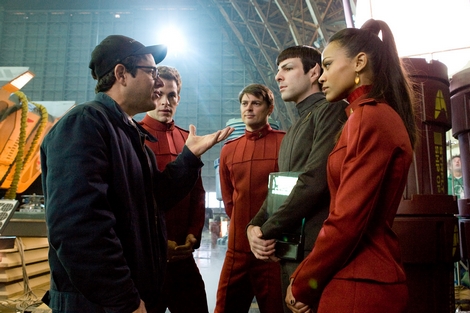
JJ with Chris Pine, Karl Urban, Zachary Quinto and Zoe Saldana at Academy Hanger location
One Goes Where No Man Has Gone Before!
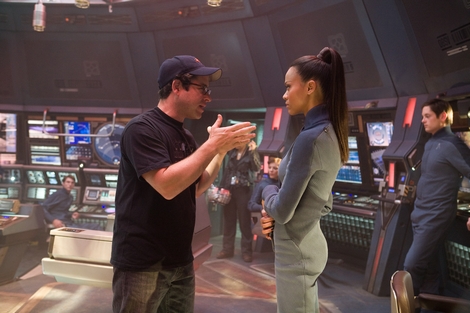
JJ with Zoe Saldana on Kobayashi Maru simulator set

JJ with Chris Pine on Kobayashi Maru simulator set
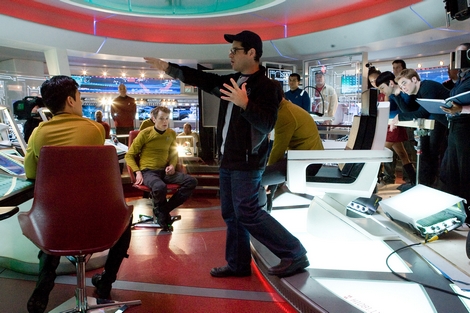
JJ with cast on bridge set of Enterprise
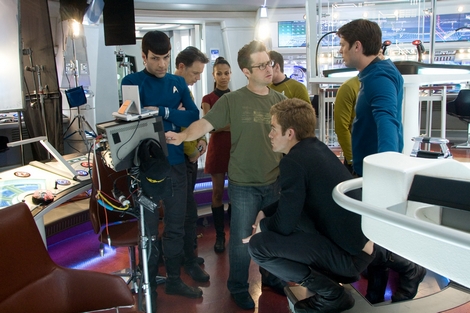
JJ with cast on bridge set of Enterprise
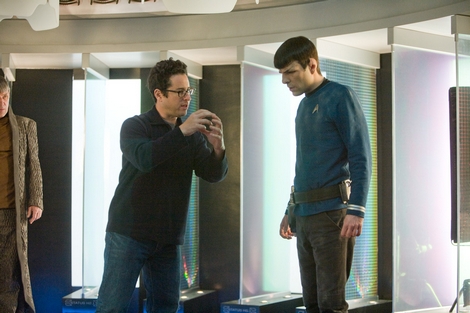
JJ with Zachary Quinto in transporter room set
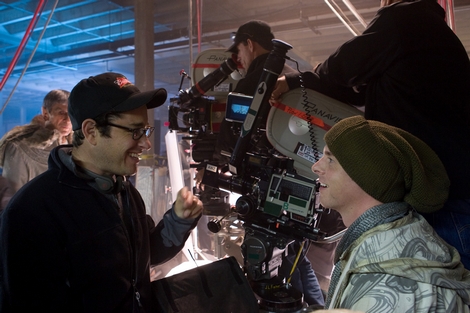
JJ with Simon Pegg in Scotty’s lab set (Leonard Nimoy in background)
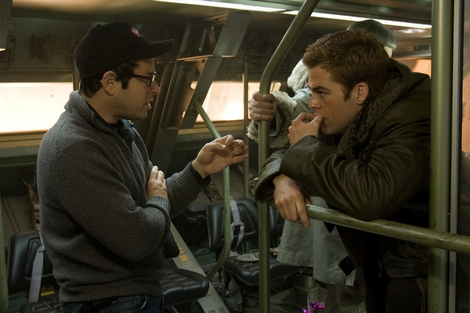
JJ with Chris Pine in Scotty’s lab set
05 May 2009
This is ONE UGLY STORY!
Prison-reform advocates call for an investigation after Chicago Tribune finds what prison experts call a fatal mistake
By Gary Marx | Chicago Tribune reporter
May 5, 2009
Joshua Daczewitz was a first-time inmate at a minimum-security prison when he tested positive for cocaine.
So corrections officials transferred the pudgy, bespectacled Daczewitz to one of the state's toughest prisons as punishment and put him in a cell with Corey Fox, a lifer in for murder. That turned out to be a fatal mistake.
With a history of violence even behind bars, Fox had been locked up alone for a year not long after pummeling and threatening to kill a cellmate and confessing to his desire to kill again. Yet after Fox was transferred to Menard Correctional Center in late 2003, several staffers at the maximum-security prison cleared him to share a cell with Daczewitz.
On Feb. 27, 2004, Fox says he passed a note to a corrections officer threatening to "erase" Daczewitz if he wasn't moved out. Daczewitz repeatedly kicked and beat on the cell door, begging to be removed, according to Fox.
By late morning, Fox knocked Daczewitz to the floor with a single punch, grabbed a makeshift rope hidden under his mattress and began choking him, according to the records. When the rope slipped off, he strangled Daczewitz, 22, with his hands.
Confronted by a Tribune reporter with the evidence of negligence, one top corrections official admitted that staffers erred by putting Daczewitz in the same cell with Fox.
Also, two other former high-ranking prison officials insisted a low-security inmate such as Daczewitz should never have been moved to a maximum-security prison for a drug violation in the first place.
But folks, this is THE line from the killer's mouth:
"Daczewitz was like a mouse in a maze of lions," Fox, 34, said in a chilling letter to the Tribune in February. "He should have never been in the cell to begin with. ... Daczewitz was given to me, like the blood of a lamb."
Like, Whoa!
One prison expert, after reviewing documents about the case provided by the Tribune, called for an independent probe into whether prison staffers should be disciplined for housing Fox and Daczewitz together.
Charles Fasano of the John Howard Association, a prison watchdog group in Chicago, said prison officials also should re-examine their practice of transferring inmates from minimum- to maximum-security prisons for nonviolent rules violations. "Daczewitz was a lightweight who should not have come anywhere near Menard," Fasano said. "It's overkill to send Daczewitz to a maximum-security prison. And Fox shouldn't have had a cellmate, period. The guy was a ticking time bomb."
Daczewitz's murder was not just the result of a misguided policy or the misjudgment of a few corrections staffers, Fasano said, but also a tragic consequence of an overcrowded prison system in which officials are under intense pressure to "double-cell" even the most violent offenders, sometimes leading to deadly results.
The Illinois Department of Corrections defended its safety record, saying only nine inmates have been killed in the last 12 years for a system that holds some 45,500 offenders. "These things can and will happen," said Sergio Molina, the corrections department's executive chief. "We try to work diligently to make sure that these incidents don't happen, and I think the numbers reflect that we do a very good job."
Well, that's reassuring.
In court papers, Daczewitz's aunt and adoptive mother, Sherree, said she remains devastated by his murder. She declined to talk to the Tribune because of her continuing grief. "Joshua was a gentle person, and for him to have been so violently killed makes me feel overwhelmed with a deep feeling of sadness and loss," she wrote before the state settled her wrongful-death lawsuit for $150,000 last December. - And that's all she got? Her lawyers suck - a child could have convinced a jury to award $1 million with this amount of negligence evidence.
Just three weeks after beginning a 7-year sentence for arson and robbery, Daczewitz failed a drug test at the minimum-security Vienna Correctional Center and was shipped to Menard on the same day.
Several top corrections officials said it was common to transfer low-security inmates to maximum-security prisons for drug violations, but others disputed that. Salvador Godinez, the former chief of operations for state prisons at the time of Daczewitz's murder, said it usually took an egregious offense such as an attack on an officer for that big of a jump.
Eugene McAdory Jr., then Menard's warden, said he urged a superior not to send Daczewitz to Menard because of his fears that he would be preyed on. McAdory said the official, Richard Bard, ignored his warning.
Daczewitz had difficulty adjusting to the maximum-security prison, though for a time he got along with Fox, playing cards and chess and sharing books. In writing to his mother and other relatives, Daczewitz said he cried every day and bitterly complained about some corrections officers. "A few of them saw me crying the other day and asked me if I wanted one of them to tuck me in," he wrote.
In the days before the murder, several inmates said they heard Fox bullying and threatening Daczewitz, according to prison records and the lawsuit. Fox told the Tribune that he and Daczewitz repeatedly spoke to guards and even wrote corrections officials demanding to be separated. Fox said he passed a note to Christopher Fleming, a guard, the morning of the murder telling him to "move my cellie or I'm going to erase him," according to the records.
In sworn statements in the lawsuit, several guards either couldn't recall being warned of problems between the cellmates or denied any problems existed.
Fleming said it was not his duty to protect inmates. "It's our job to see he ... doesn't escape," Fleming said in his deposition. "As long as they're in the cell ... that's our job."
On the morning of the murder, Daczewitz spent almost three hours "kicking and beating on the cell door, crying, begging, pleading to be taken out," Fox wrote the Tribune. "Each officer that passed by ignored him or walked off the gallery laughing, as if it were all a joke."
Fed up with the inaction, Fox said he jumped off the top bunk and punched Daczewitz in the mouth, knocking him to the floor, according to the records. Before Daczewitz could rise, Fox pulled Dazcewitz's head back by the hair and strangled him.
Fox is now locked up at least 23 hours a day in solitary confinement, in a cell at "super-max" Tamms Correctional Center after receiving a life sentence for Daczewitz's murder. His head shaved and goatee braided, Fox declined to give a reason for killing Daczewitz but said he felt no remorse. "If I felt like it, I'd take another life," he boasted.
Like brotha Snoop-Dogg always said, "Why ask why?"
04 May 2009
The President in HD
Other than grouping him up under his presidential sheets! Michelle wouldn't like that, girls.
5/2/09: Your Weekly Address from White House on Vimeo.
03 May 2009
And you wonder...whatever happened to those Hip-Hop Pioneers?
Roxanne Shanté
From Wikipedia, the free encyclopedia
| This biography of a living person needs additional citations for verification. Please help improve this article by adding reliable references (ideally, using inline citations). Unsourced or poorly sourced contentious material must be removed immediately, especially if potentially libelous or harmful. Find sources: "Roxanne Shanté" — news, books, scholar (June 2008) |
| Roxanne Shanté | |
|---|---|
| Birth name | Lolita Shanté Gooden |
| Born | November 9, 1969 (1969-11-09) (age 39) |
| Origin | Queens, New York |
| Genre(s) | Hip hop |
| Occupation(s) | Emcee Psychologist |
| Years active | 1984–1994 |
| Label(s) | Pop Art Records 10/Virgin Records Breakout/A&M Records Cold Chillin’/Reprise/Warner Bros. Records Livin’ Large/Tommy Boy/Warner Bros. Records |
| Associated acts | Juice Crew Marley Marl Big Daddy Kane Biz Markie Kool G. Rap & DJ Polo M.C. Shan Craig G The Real Roxanne Steady B Sparky Dee |
| Website | The official MySpace page of Dr. Roxanne Shanté |
Roxanne Shanté, Ph.D. (born Lolita Shanté Gooden, November 9, 1969) is an American hip-hop pioneer. Born and raised in the Queensbridge Projects, Shanté first gained attention through the Roxanne Wars and her association with the Juice Crew.
Biography
Shanté's career began at the age of 14 when she encountered influential record producer Marley Marl, radio DJ Mr. Magic, and Tyrone Williams talking about how UTFO had canceled its appearance at a show that it was promoting. Shanté offered to record an answer to UTFO's recent hit "Roxanne, Roxanne," which was about a woman named who rejects the members of the group. The men agreed and the result was "Roxanne's Revenge," a confrontational and profane song in which Shanté assumed the role of Roxanne, dissing UTFO over a Marley Marl-produced instrumental (The official UTFO response to the its own song was “The Real Roxanne,” with artist Adelaida Martinez assuming the role of Roxanne and eventually recording under the same stage name as the song title). Shanté's version and the Real Roxanne's version sparked the Roxanne Wars and made Shanté a hip-hop star in the process. The single would go on to sell over 250,000 copies in the New York area alone. One of the founding members of the Juice Crew, most of her tracks would be produced by Marley Marl, with the exception of several songs on Shanté’s last album, 1992’s The Bitch is Back.
As an MC, Shanté had an extraordinary ability to freestyle (improvise) entire songs. "Roxanne’s Revenge" was an example, reportedly written as it was recorded—in one take.[citation needed] However, the original version of the song was rerecorded after UTFO sued over the usage of its original backing track; the new version featured slightly different music with less profanity. People are most familiar with this version, which appears on the original 12-inch single released in 1984, with the original on the reverse side.
In 1988, Shanté and Rick James had a hit with "Loosey's Rap."
At the age of 25, Shanté retired from the recording industry to become a psychologist. She continues to make occasional guest appearances and live performances, as well as mentor young female hip-hop artists. She did the latter by making a cameo appearance on VH1's hip hop reality show Ms. Rap Supreme and gave rap-battle strategies to the finalists of that show. She also took part in a series of Sprite commercials during the late 1990s. She is married and has one son and one daughter, the first child of which was born when she was 14. She earned a PhD in psychology from Cornell University[1][2][3]—paid for by her record label via an unusual contract clause—and has a practice in Queens.[4] She is a vegan and owns Hip-Hop Ices ice cream parlor in Queens.
She will be portrayed by actress Keke Palmer in The Vapors, a film about the formation and rise of the Juice Crew.[5]
In 2008, her song "Roxanne's Revenge" was ranked number 42 on VH1's 100 Greatest Hip Hop Songs.
Social Networking - Introducing Meetup.com
In actuality, this isn't even a new site. Been arond since at least 2006, it's good for meeting people not only online but live in person doing things you like to do. You simply sign up, indicate your personal interests and preferences for groups you're trying to meet, and WHAM!! you have it. whether you're into archery or golf, restaurant-hopping or wine tasting, meeting local or traveling anywhere in the world, meeting fellow partiers or a book club, this group will link you up with people who share your interests.
And unlike Facebook, you actually "meet up" with these social networking friends. So no gabbing all day and night online, there's actually something for us to do! Also excellent for meeting and making new friends and network contacts. To check it out, click on the "Meetup" logo above.
Happy Meetups!!!


